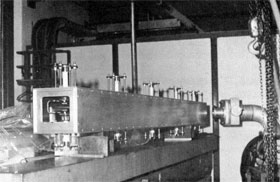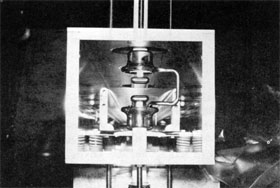Switchyard Group Readies 3-Way Split
PROGRESS REPORT FOR JANUARY, 1973
During the month of January, in the course of a successful high energy physics run, an integrated exposure of 1017 protons was reached. The first beam splitting station was initially tested on Saturday, January 6. Injection of twelve Booster pulses for each Main Ring pulse became a regular mode of operation. The accelerator ran consistently at 1.8 X 1012 protons per pulse at 300 BeV.
The Switchyard group in NAL's Accelerator Section was never satisfied with the status. The modifications to improve operations of the accelerator, which were this group's responsibility, were tested on January 6, 1973. The first "splitting station" in the beam transport line successfully "sliced" the beam coming from the accelerator, sending 25% of it to the Proton experimental area and 75% to the neutrino experimental area, at the same time. The test run activated the first of two new splitting stations. The second station was installed during the week of January 28, 150 feet farther from the accelerator on the transport line, adding the Meson Area to the new arrangement and resulting now in a 3-way split capability. Station #2 was tested for operations. Further tuning of the new apparatus, together with related alignment work, continued for several weeks.
"We must still try for perfect splitting," said Les Oleksiuk, who led the January effort in the Switchyard group, "so as to not disturb beam trajectory. We want to cut the beam neatly and cleanly without affecting the beam spot."
Many Switchyard staff members were involved in the splitting station work. Claus Rode and Leon Bartelson handled cabling and control electronics; Les Oleksiuk was responsible for layout and beam optical design. Gene Fisk and Fred Hornstra worked on beam diagnostics and loss monitor. Design parameters of the Lambertson magnets were the results of a collaboration of Rode and Oleksiuk; Ed Bleser and Dick Andrews supervised the wire septum modules. Under Andrews' direction, Richard Krull and Butch Bianchi built, tested, and assembled the wire splitter.
Two basic components accomplished the splitting action. The first was an electrostatic wire septum, composed of a 10 ft. array of parallel, hair-like, stretched tungsten wires surrounded on each side by strong electric fields. When the beam encountered this device, an effect similar to the peeling of an orange resulted - the tiny 2/1000" wires act like a knife edge, and the diverging electric fields provided the necessary wedging action to separate the beam into two distinct portions. Four-10 ft. wire septa were installed in the Switchyard complex, two in each of the splitting stations.
Once the beam was split into two portions, each portion goes in a different direction. Further splitting was accomplished by a special "Lambertson Septum" magnet, designed and built by the NAL Magnet Fabrication group under Will Hansen. This device provided a magnetic deflecting kick to one of the split portions of the beam, while simultaneously shielding the second portion from this deflecting force. In this way, a very strong "parting of the ways" occured between the two beams; about 1/2 degree in angle. From then on, each split portion acted like a distinct beam handled with the -usual type of bending and focusing magnets.
A special array of small bending magnets was used to "bump" the original beam on to the wire splitters; varying this "bump" allowed varying the splitting ratio between any two experimental areas. The needs of different experiments vary greatly. Some need many protons (high intensity with high energy, such as neutrino experiments. Others need less intensity of less energy. The more experiments that can be accommodated at one time, the more experimental work can be accomplished. In a sense, the duty factor of the machine was increased by 200% with the activation of the beam splitting feature since three experiment lines could operate at once, instead of one at a time.
Future splitting stations were designed for the Proton Experimental Area, and also for the Neutrino targeting areas.

This device in the beam transport line, was vital to the new beam splitting technique. It was built by NAL's Magnet Fabrication group

A close-up of the new Lambertson Septum which accomplishes beam splitting


